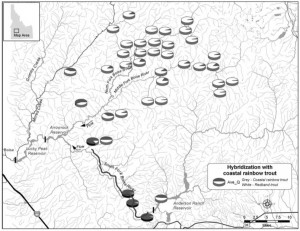An article in a recent issue of the North American Journal of Fisheries Management takes a look at the South Fork Boise River wild trout fishery in the context of genetic background of the redband/rainbow trout residing in the upper Boise River basin.
Authors Helen Neville (Trout Unlimited Boise office) and Jason Dunham (US Geological Survey, Corvallis, OR) studied the hybridization of the redband trout due to the historic stocking of hatchery-raised coastal rainbow trout in the South Fork Boise River until the late 1970s, and compared genetic information on the South Fork trout with samples of trout from tributaries in the North and Middle forks of the Boise River.
It was the 2008 fish sampling genetic study that provided the basic information for the genetic analysis, and ultimately this report. Using the genetic analysis plus fish stocking records dating back several decades the authors concluded the following:
Intraspecific hybridization was considerably more widespread (almost 40% of sampled locations), and several local populations of native redband trout have been almost completely replaced with hatchery coastal rainbow trout O. mykiss irideus; other populations exist as hybrid swarms, some are in the process of being actively invaded, and some are maintaining genetic characteristics of native populations. The persistence of some redband trout populations with high genetic integrity provides some opportunity to conserve native genomes, but our findings also highlight the complex decisions facing managers today.
In recounting the fish stocking records and genetic results the authors paint a picture of the history of fisheries management that over time moved from providing a fishing experience based on hatchery fish and liberal bag limits, something that was pretty uniform across the landscape 40 to 50 years ago. Then, as fishing pressure increased additional hatchery fish could be planted (assuming the money was available to grow more fish, or they could be reallocated from elsewhere). But with the growing interest in wild trout and a catch-and-release sport fish ethic, the other options of smaller bag limits or no-kill rules, and restrictions on gear came in to the mainstream.
The authors cite a study that also points to habitat modification playing a role:
Extensive modification of this habitat may also have played a role (Allendorf et al. 2001): dam construction and flow management in the 1940s and 1950s likely caused the near extirpation of native trout in this section of river and may have facilitated their replacement by coastal rainbow trout.
Modern day anglers would be shocked to learn that in the year or two following construction of Anderson Ranch Dam that river flows were sometimes cut to five cubic feet per second (5 cfs!) to fill the reservoir. That, coupled with continued stocking, plus a high harvest rate would combine to affect the native redband. In recent decades the wild fish that spawn mainly in the mainstem SFB river carry the coastal rainbow and redband genetics as the locals and the new arrivals spawned and reproduced.
This study adds an important element of understanding the role of genetics in the SFB fishery in comparison to the upper Boise River watershed where native redband trout are still a prominent feature on the landscape.







